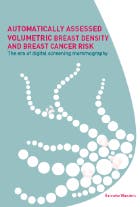Hanneke Wanders
Automatically assessed volumetric breast density and breast cancer risk: The era of digital screening mammography

- Datum
- (Co) promotoren
- 22-06-2017
- prof.dr. P.H.M. Peeters, prof.dr. N. Karssemeijer, dr. C.H. van Gils
Samenvatting
Breast cancer is the most frequently diagnosed cancer among females worldwide. As the burden of breast cancer is high, many countries have introduced a breast cancer screening program with the aim to find and treat breast cancers in an early stage. In the Netherlands, women between the ages of 50 and 75 years are screened every two years using mammography. It has been known that the screening sensitivity is reduced in women with high mammographic density (i.e. high amount or percentage of fibroglandular tissue in the breast). Additionally, these women have a higher breast cancer risk. Previously, mammographic density was measured as the projected area of the dense tissue on a two-dimensional image. With the wide introduction of digital mammography, fully automatic assessment methods were developed to measure breast density in a three-dimensional (volumetric) fashion. The main aim of this thesis was to investigate the association between volumetric breast density and breast cancer risk and its influence on screening performance. We observed that screening sensitivity is lower in women with higher volumetric mammographic density (61% versus 86% in women with low breast density), also in the era of higher-contrast digital mammography. This is despite the higher recall rates among women with denser breasts. False positive rates are also higher in these women. As screening performance varies with mammographic density, and mammographic density is related to breast cancer risk, personalizing the screening based on breast density and breast cancer risk is discussed widely. In this light it is important to know whether absolute or percentage volumetric breast density, two commonly used measures of density, is more strongly associated with breast cancer and especially with tumors that are not detected at screening mammography (interval breast cancers). We observed that absolute dense volume and percentage dense volume are to a similar extent associated with breast cancer risk. Both are particularly strongly related with interval cancer risk, and this relationship appeared most pronounced for percentage dense volume. The use of another mammographic feature, namely texture pattern scores (a measure to quantify structural patterns on mammograms) improved breast cancer risk prediction next to volumetric breast density. Breast density is not constant but declines with increasing age in most women, especially around menopause. In this thesis we were the first to study changes in automatically measured breast density in relation to breast cancer risk. Women who kept having dense breasts over time seemed to have a higher breast cancer risk than women who changed from having dense to having nondense breasts. However, this difference was not statistically significant. The length of the follow-up was still relatively short however (4.3 years) and changes measured over a longer time might provide a clearer view on the effects. In summary, we found that volumetric breast density strongly hampers screening performance and is associated with breast cancer risk, particularly with the risk of interval cancers. Supplemental imaging with more sensitive imaging techniques could be beneficial for this selected group of women and is currently under study.
